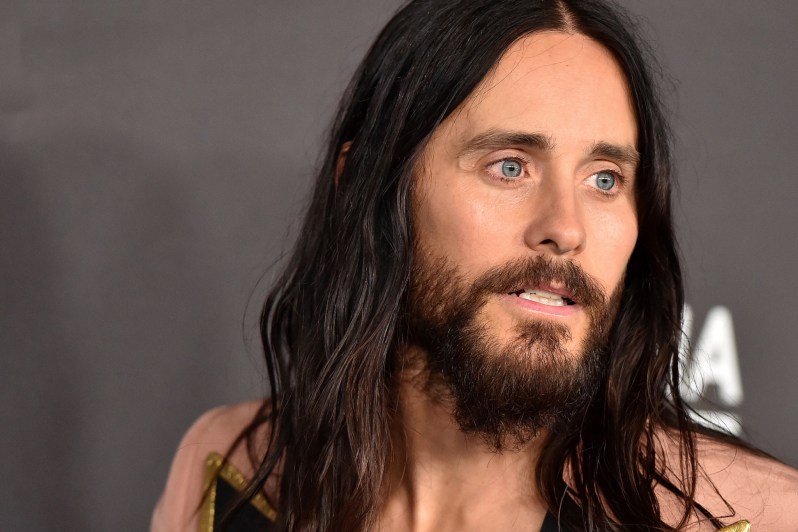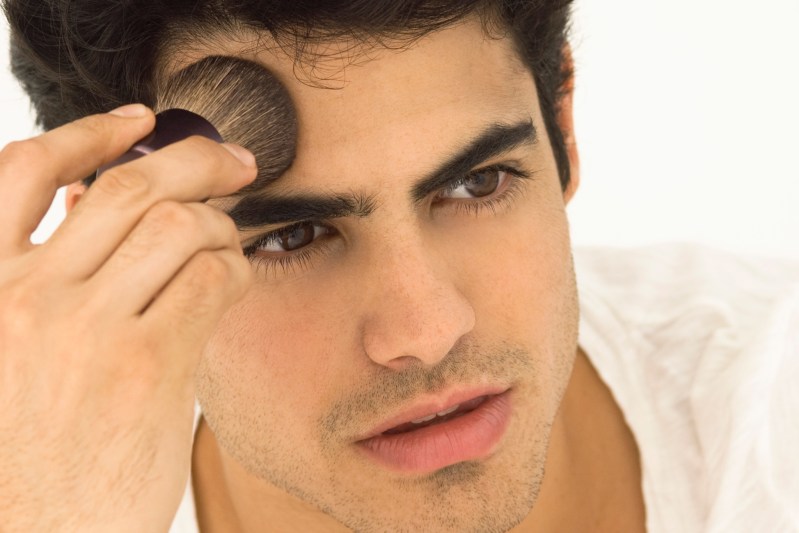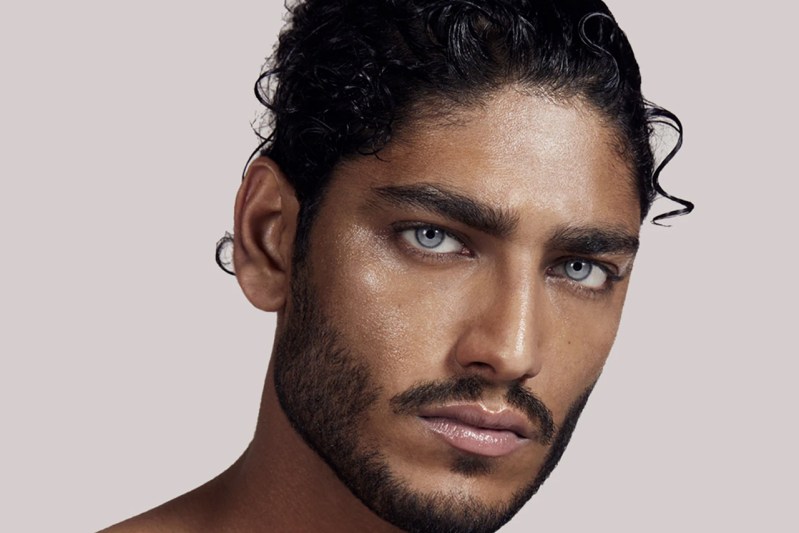Let’s get this out of the way first: You’re a man. Like, a real man. Strong, smart, sensitive in all the 2019-approved ways. As such, you’re totally fine with anyone wearing makeup if they want to. Including other men. If that’s their thing, they should totally do it. But you wear makeup? Hell, no.
Except statistics suggest that you might. In an October 2019 poll from Morning Consult, one-third of young men said they would consider wearing makeup, while 23% of all men said the same. Meanwhile, worldwide sales of men’s beauty products have been growing faster than women’s sales since 2010. And it’s not for no reason that renowned fashion houses like Chanel, Jean-Paul Gaultier, and Tom Ford have been releasing capsule collections of men’s cosmetics over the last decade.
As far as modern society has come in flexing the hidebound rules around gender stereotypes, makeup is one arena where men still seem compelled to parrot the old Seinfeld line, “No way … not that there’s anything wrong with that.”
Talking in the abstract about men wearing makeup is fodder for an interesting conversation. But let anyone in that conversation mention that they passed a Chanel counter featuring contour or mascara for male use, and the men in the conversation (the straight ones, anyway) are likely to react as though they’d been accused of borrowing their sister’s underwear.
Self-empowerment was the theme of men’s makeup use throughout history. Far from being sneered at, powdering your complexion or painting up your eyes and lips was a power move.

Which is odd, considering how many icons of modern masculinity use makeup on the regular to enhance their good looks, play down their flaws, or simply stand apart from the pack. Male makeup is a given on the red carpet, with professional hunks like Jared Leto, Daniel Kaluuya, and Zac Efron sporting “guy-liner,” mascara and even foundation to ensure that every angle is a good one. Shrugging that off as Hollywood phonyism? Then consider the long-standing tradition of rock gods who make no secret of their cosmetic use. Bob Dylan, Freddie Mercury, Prince, and Billy Joe Armstrong are just a few, to say nothing of the outré looks sported by David Bowie, Alice Cooper, and the members of KISS.
This wasn’t just a concession to some label trying to create an image. As face-painted punk icon Billy Idol told GQ, “The fashion and makeup, it made a statement, which was that you can control your own image. You can create yourself.”
In fact, self-empowerment was the theme of men’s makeup use throughout history. Far from being sneered at, powdering your complexion or painting up your eyes and lips was a power move. The classic cat-eye look was created by the ancient Egyptians — male, not female — as a symbol of wealth and status. It was later combined with mineral-based green eye shadow which was believed to ward off illness. (Apparently green was the favorite color of whatever deity was in charge of health.) Roman men in the first century A.D. habitually rouged their cheeks and even painted their nails. Their counterparts in Elizabethan England and Louis XVI’s France powdered their faces to a pale white complexion and painted on beauty marks. And let’s not overlook the indigenous nations from the United States to Indonesia who ritually paint their faces for both spiritual protection and enemy intimidation. Throughout time and across cultures, wearing makeup was the sign of a self-empowered man.

It wasn’t until the Victorian era came along, with its soul-crushing morality and fetish for guilt, that makeup was designated as the purview of women only. (Because, as we all know, women are vain and crafty temptresses bent on deceiving virtuous men.) But the rise of the movie industry made it once again acceptable for men to wear makeup, at least in a specific professional environment.
Given this history, it’s not surprising that the age of social media is propelling men’s makeup to greater prominence than ever before. With our likenesses showing up everywhere, often without our ability to prepare (much less our explicit consent), it’s perfectly understandable that men would want to be as camera-ready as possible.
Still, men remain largely reticent about whether they use makeup, though many are perfectly willing to admit they know “a lot of guys” who do. At most, you might find a guy who cops to wearing concealer if they’re having a bad skin day or bronzer if their complexion isn’t summer-ready.

That’s OK. Change takes time, and usually a few bold proponents. For decades, men’s skincare was considered effete until macho men like Dwayne “The Rock” Johnson and Rob Lowe started publicizing their devotion to exfoliation and hydrating serums. As more men come clean about their beauty regimens, we’re pretty sure it’s just a matter of time before society sees nothing anti-masculine about men applying a little eyeliner for a black-tie affair or swiping some glow serum over their cheekbones to impress a date.
If that freaks you out, it might be worth considering why. Is it because you don’t want to have to wear makeup, and the rise of male makeup feels like impending pressure? That’s fair, and plenty of women out there will commiserate with you.
For those who identify as men, makeup can be an opportunity to break free from the confines of male stereotypes. With just a little swipe of lip balm or a pencil to the eyebrows, you can give the finger to what society says a man “ought” to be and redefine it as the man you truly are.
Rest assured that this trend is really not about society’s expectations compelling men to start wearing makeup on a daily basis. In fact, it’s about subverting society’s expectations altogether. Anyone should feel comfortable wearing makeup if they want to, without any impact to their personal identity or external perception. Even as the bigger brands are pointedly marketing their cosmetic products to men, a number of small, independent companies are playing the long game by taking a “genderless” stance.
One such brand, CTZN, was started by two women of color who got frustrated with the lack of representation in mainstream beauty campaigns and product lines. “We were essentially overlooked,” CTZN co-founder Aleena Khan told us, “and we knew we were not alone in sharing that sentiment. It was not just women of color who felt underrepresented by the beauty industry — a significant percentage of men felt excluded as well.”

In the effort to create a truly inclusive beauty brand, they accomplished the rare feat of reconnecting with makeup’s ancient roots as a “power tool,” with an egalitarian twist that perfectly suits the emerging culture of today. “Using beauty as a power tool is basically doing more with beauty-enhancing cultural awareness through beauty content. By detaching gender from the conversation, we are simply saying that whoever wears makeup is welcome here.”
For those who identify as men, makeup can be an opportunity to break free from the confines of male stereotypes. With just a little swipe of lip balm or a pencil to the eyebrows, you can give the finger to what society says a man “ought” to be and redefine it as the man you truly are.
Best Makeup for Men
If you’re a man interested in learning more about what makeup might mean for you, here are a few places to start exploring:
CTZN Cosmetics Globalm

A no-rules clear gel that can be applied anywhere on the face (lips, eyelids, cheekbones, etc.) to add healthy, dewy shine.
Stryx Concealer Tool

This ultra-discreet pencil-sized concealer stick effectively hides pimples, razor burn, scars, and other imperfections.
Tom Ford Brow Gelcomb

With a specially designed precision come and twist-up applicator, this lightweight gel will easily tame the unruly brow.
Boy de Chanel Lip Balm

This transparent, non-shiny balm will smooth, hydrate and nourish lips for over 8 hours, making for one hell of a makeout sesh.
War Paint Anti-Shine Powder

This transparent powder blots out unwanted oils, shine, and sweat, leaving a smooth matte finish.
Altr Blemish Balm

The subtle tint conceals spots and brightens appearance, while botanical extracts rapidly repair and hydrate dry and damaged skin.


